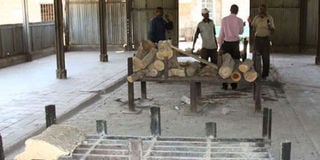Kenneth Matiba send-off: Nothing new about cremation in Kenya

The Kariokor Crematorium in Nairobi on October 4, 2011. PHOTO | NATION MEDIA GROUP
What you need to know:
- Cremations in modern day Kenya were associated more with the arrival of Hindus during the building of the Uganda Railway.
- Former Cabinet Minister Peter Habenga Okondo and the Nobel Laurette Wangari Maathai bodies were cremated at Kariokor.
At the National Museums of Kenya are pot-sherds, beads and burnt human bones in one of Kenya’s oldest crematoriums – known by archaeologists as the Njoro River Cave site.
As debate kicks off once again on cremation – following revelations that politician Kenneth Matiba’s would be cremated – unknown to many, Kenya has one of the oldest crematoriums in East Africa, dating back more than 3,000 years.
The remains, preserved in boxes, were excavated in April 1938 by Louis Leakey, a promoter of the study of human origins, having been discovered by Mrs Nellie Grant, the mother of famous writer Elspeth Huxley, the author of TheFlame Trees of Thika.
“Going by the evidence at Njoro River Cave, cremation is an old practice in Africa,” says Dr Purity Kiura, a research scientist at the museums.
“We also have burial sites in northern Kenya, which also point to the beginning of burial practices rather than discarding of bodies. The best known is the Namoritunga site on the western side of Lake Turkana.”
DISCOVERY
But it is the cremation at Njoro that has always astounded researchers.
“Njoro was an interesting site in the history of cremation in Kenya,” Dr Kiura says.
When it was excavated, Dr Leakey with his wife, Mary, removed the remains of 74 individuals cremated and buried with their beads, pots, baskets and one wooden vessel, now housed at the museum in Nairobi.
While Dr Leakey had at first thought that the remains belonged to some “Mesopotamians”, and he told The Times as much, he would later discover that what he thought was evidence of opal mining in Africa turned out to be beads at a cremation site by local inhabitants.
The site became of interest to archaeologists.
Apart from the stone bowls, the presence of pestles and mortars did suggest that the crematorium existed during a time when people knew how to ground grain.
CUSTOM
Before the discovery of the Njoro River Cave site, it was always thought that burnt human remains at some sites were accidental and not an ancient burial custom.
Other smaller crematoriums were discovered at the Keringet and Egerton caves.
In their book Excavations at the Njoro River Cave, Mary and Dr Leakey say the excavation yielded at least 42 males, 21 females and 11 individuals “too poorly preserved to make a sex determination”.
“Of the males whose age can be estimated, 15 out of 34 never reached even early middle age, while 20 never reached full middle age. Only one reached an advanced age,” the two wrote after studying the remains.
While no cremation sites have been found during the iron-age, cremations in modern-day Kenya were associated more with the arrival of Hindus during the building of the Uganda Railway.
It was the Mombasa Hindu Union, founded in 1899 – when the railway reached Nairobi – that build the first crematorium in Mombasa in 1904, near the Shivalaya Temple, to serve the Hindus, Jains and Sikhs.
It also served others who chose to cremate the dead rather than bury them.
KARIOKOR
In the interior, other crematoriums were set in Nakuru and Nairobi in 1907.
The Kariokor Crematorium was opened in 1933 and remains the best known in Kenya.
In 1967, there was debate in Parliament seeking the removal of Kariokor “from an African area”, with Butere MP Martin Shikuku arguing that the smell of “the smoke from dead Indians” was offensive to residents.
But then Parklands MP F.R.S. De Souza told him off, saying that cremation was the “cleanest and healthiest way of getting rid of the dead”.
POLITICIANS
In 1974, Attorney-General Charles Njonjo also sparked debate in Parliament when he suggested that the dead “should either be cremated or thrown to the hyenas”.
The first high-ranking Kenyan to be cremated was Cabinet minister Bruce Mackenzie, who for many years was Jomo Kenyatta’s minister for Agriculture. He was cremated in 1978.
The bodies of former Cabinet minister Peter Habenga Okondo and Nobel laureate Wangari Maathai were cremated at Kariokor.
In 2002, the cremation of Mary Kuria, the wife of Archbishop Manasses Kuria of the Anglican Church, caused uproar within the church.
“We do it because it is Christian,” said Bishop Kuria, whose body was also cremated.
When she died in 2011, Prof Maathai was cremated, in what is catching up to be a tradition in Kenya.




